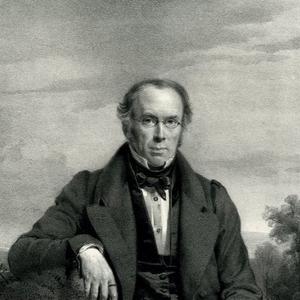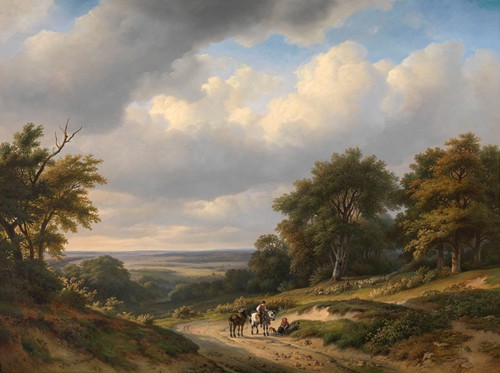

Jan Baptiste de Jonghe
Jan Baptiste de Jonghe or Jean-Baptiste de Jonghe was a Belgian painter, draughtsman, etcher and lithographer. He is known for his Romantic landscapes with people, herds and ruins. In his graphic work he also made views of cities in the area of what is now Belgium and the Netherlands. He was an art professor at the Academy of Kortrijk and the Antwerp Academy of Fine Arts.
Jan Baptiste de Jonghe was born in Kortrijk as the son of a wealthy businessman who was mayor of Kortrijk from 1805 to 1817. He received his first training at the Academie van Kortrijk, where he studied for two years. His drawing instructor was the sculptor Pieter Van Reable. He then went to study at the Antwerp Academy of Fine Arts. Here one of his professors was the renowned animal and landscape painter Balthasar Paul Ommeganck. Ommeganck is believed to have set de Jonghe on the path of landscape and animal painting. When in 1812 he won the prize for landscape painting at a competition organized by the drawing academy of Ghent, he started to fully concentrate on this subject matter.
He participated in various other art competitions in Northern France and Belgium and was successful in Douai, Brussels and Bruges. He travelled in The Netherlands, France and England.
In 1823-1824 he was one of the lithographers who made lithographs and provided drawings for the publication Collection des principales vues des Pays-Bas ('Collection of principal views of the Netherlands') published by Dewasme.
In 1825 the Academy of Antwerp admitted de Jonghe as a member. The next year he was appointed professor at the Academy of drawing and architecture in Kortrijk. In 1828 he was admitted as associate member of the Academy of Amsterdam. In 1836 the Belgian government appointed him to the jury tasked to choose the artwork to be acquired by the Belgian state at that year's salon. In 1840, Belgian King Leopold I commissioned from the artist six landscape paintings of sites in the Ardennes.
In 1841 de Jonghe was appointed professor of landscape and animal painting at the Academy of Antwerp. He only served in that role for a brief period as he had to resign for family reasons in 1843. After this he was occupied with various commissions in Brussels.
De Jonghe also played an important role as a teacher at the Academy of Kortrijk, where he trained a new generation of painters between 1826 and 1841, including Jean Baptiste Daveloose and Louis-Pierre Verwee. Other pupils of de Jonghe include Louis de Winter, Louis Robbe and Hendrik Frans Schaefels. Gustave Léonard de Jonghe, the son of the artist and his wife Maria Theresia Commeijne, received his first training from his father and became a society portrait and genre painter who worked in Paris for a fashionable clientele.
The artist died in Schaerbeek in 1844 after a brief illness.
